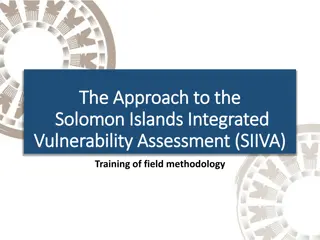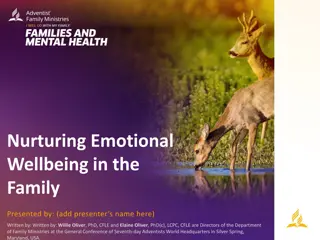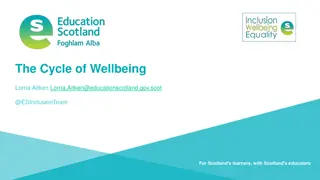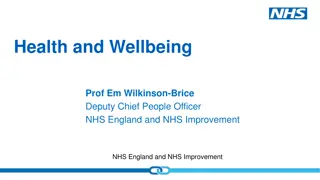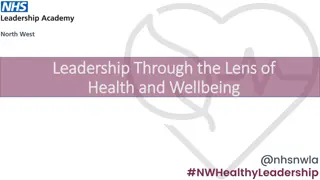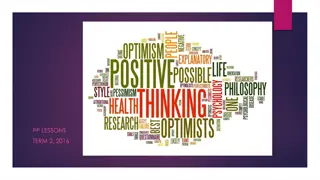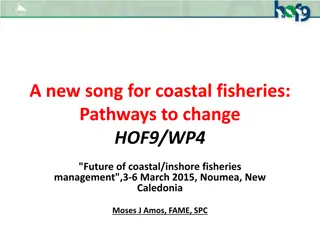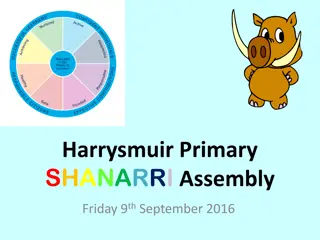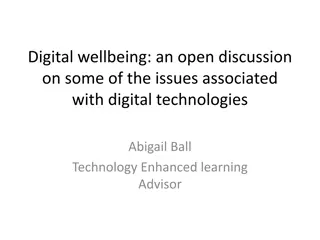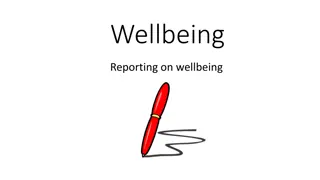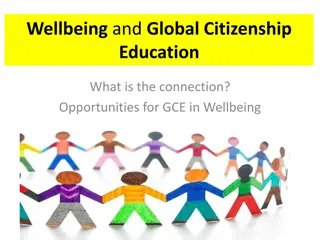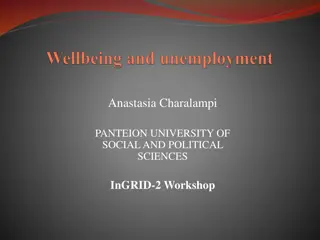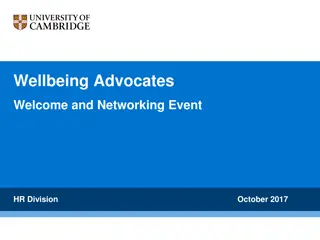Livelihoods and Wellbeing: A Sustainable Approach
Livelihoods encompass an individual's way of living to meet basic needs and aspirations, influenced by assets, capabilities, and activities. This session aims to enhance comprehension of these concepts by introducing the Sustainable Livelihoods Framework. It emphasizes the importance of understanding livelihood strategies, differences within communities, and factors influencing decision-making. Exploring the cultural, social, and economic values of environments expands awareness of diverse livelihoods, supporting responsible decision-making for social and environmental well-being.
Download Presentation

Please find below an Image/Link to download the presentation.
The content on the website is provided AS IS for your information and personal use only. It may not be sold, licensed, or shared on other websites without obtaining consent from the author.If you encounter any issues during the download, it is possible that the publisher has removed the file from their server.
You are allowed to download the files provided on this website for personal or commercial use, subject to the condition that they are used lawfully. All files are the property of their respective owners.
The content on the website is provided AS IS for your information and personal use only. It may not be sold, licensed, or shared on other websites without obtaining consent from the author.
E N D
Presentation Transcript
Objective of the session To increase understanding of the concepts of livelihoods and wellbeing, and their connection to the cultural, social and economic value of the environment To introduce the Sustainable Livelihoods Framework as a tool for thinking about and understanding people s livelihoods strategies To raise awareness of how livelihoods strategies differ between and within communities, and the factors that affect the choices people make and the outcomes they achieve 2
What are livelihoods? A person's livelihood refers to their way of living in order to secure the basic necessities of life (food, water, shelter and clothing) and other outcomes that they aspire to Entitlements refer to people s human rights, which include economic, social, cultural and political rights A livelihood includes social and cultural means e.g. information, cultural knowledge, social networks and legal rights 3
Livelihoods - components A livelihood comprises an individual s or household s capabilities, assets, and activities: Assets are the resources people have access to, and include both material and social resources (e.g. land, a boat, rental income, union membership) Capabilities are what people can do or be with their assets and entitlements (e.g. a farmer, a nurse, a child-carer) Activities are everything that people do with their capabilities/assets to make a living (e.g. farm their land, go to the communal forest to collect fuelwood, care for their children) 4
Why we need to understand livelihoods Livelihoods are diverse, complex and dynamic Understanding this complexity contributes to socially and environmentally responsible decisions Improves understanding of both the implications of resource degradation and also the possible impacts (positive and negative) of proposed conservation and management measures 5
Some examples of livelihoods assets Human assets health, nutrition, education, knowledge and skills, capacity to work Social assets family, groups, networks, access to institutions, mechanisms for participation in decision making Natural assets land and produce, water and aquatic resources, trees and forest products, wildlife, biodiversity, environmental services Physical assets infrastructure such as roads, vehicles, shelter, water supply, energy, communications, tools and technology such as seed, fertiliser, equipment Financial assets wages, savings, credit, remittances, pensions 6
The Assets Pentagon Human Natural Social A healthy farmer, with his own land and a good knowledge of how to care for his crops LIVELIHOODS ASSETS Physical Financial Human Human Natural An educated shop keeper, with considerable savings and his own premises and truck. Social Natural Social Financial Physical Physical Financial 7
Sustainable livelihoods A livelihood is sustainable when it can cope with and recover from stresses and shocks; maintain and enhance its capabilities and assets, both now and in the future; without undermining the natural resource base. 8
Thevulnerabilitycontext The way that people can make use of their assets depends on a number of factors within the context in which they exist. This is known as the vulnerability context. Examples include: Trends population, resources, economic, governance, technology Shocks illness, natural disaster, economic, conflict, crop / livestock pests & diseases Seasonality prices, production, health, employment 9
Sustainable Livelihoods Framework: Vulnerabilitycontext LIVELIHOODS ASSETS Human VULNERABILITY CONTEXT Natural Social Shocks Trends Seasonality Physical Financial 10
Policies, , institutionsandprocesses Policies, institutions and processes include: government at all levels, political and legislative bodies, civil society, NGOs, commercial enterprises the policies of such organisations formal and informal rules and regulations, laws, social norms and customs, language and decision making processes 11
Sustainable Livelihoods Framework: Policies, , institutionsand processes LIVELIHOODS ASSETS POLICIES, INSTITUTIONS, PROCESSES Human VULNERABILITY CONTEXT Natural Social Laws Policies Institutions Governance Social norms Market systems Influence & access Shocks Trends Seasonality Physical Financial 12
Culture and livelihoods strategies Unique to a particular place and time Culture affects decision-making (choices), opportunities and outcomes Particularly affects livelihoods opportunities for women Culture is a factor in wellbeing 13
Livelihood strategies Combining: the assets people own or can access Taking account of: the vulnerability context Supported or constrained by: policies, institutions and processes Livelihood strategies aim to lead to livelihoods outcomes . 14
Livelihoodoutcomes For example: More sustainable use of the natural resource base Increased well-being (for example, self esteem, health, sense of control) More income Improved food security Reduced vulnerability (increased resilience) 15
Livelihoodstrategiesat communitylevel Understanding communities requires input from a diverse range of (representative) stakeholders Be aware of potential indirect linkages between livelihoods and environment 16
Sustainable Livelihoods Framework: Sustainable Livelihoods Framework: Complete Complete LIVELIHOODS OUTCOMES LIVELIHOODS ASSETS POLICIES, INSTITUTIONS, PROCESSES Sustainable use of natural resources More income Increased well- being Reduced vulnerability Food security Human In order to achieve VULNERABILITY CONTEXT Natural Social Laws Policies Institutions Governance Social norms Market systems LIVELIHOODS STRATEGIES Influence & access Shocks Trends Seasonality Physical Financial 17
Modified sustainable livelihoods framework Modified sustainable livelihoods framework Bennett, N.J and Dearden, P. (2014) Why local people do not support conservation: Community perceptions of marine protected area livelihood impacts, governance and management in Thailand. Marine Policy, Volume 44, Pages 107 116. doi:10.1016/j.marpol.2013.08.017 18
Livelihood strategies of real people Work in pairs Draw one of your livelihood profiles (or list some of your key assets, vulnerabilities, PIPs, strategies and outcomes) Alternatively, do this for a real person that you know well 19
Activity discussion: Looking at the livelihoods of Activity discussion: Looking at the livelihoods of participants participants What are the main assets people have access to? What are the similarities and differences between the frameworks they have drawn? Are there any trends? (E.g. do those produced by men and women have a different emphasis?) What factors (trends, shocks, seasons) commonly make people more (or less) vulnerable? What policies, institutions and processesare affecting people s livelihoods? Is there anything missing from the frameworks that have been drawn (e.g. are spiritual/religious/cultural values included)? Are there any of the livelihood profiles that are obviously more positive or sustainable than others? If so, what are their key features? 20
A sustainable livelihood outcome is A sustainable livelihood outcome is based on a diverse, balanced and robust set of livelihood assets; able to sustain itself in the face of shocks, changes or trends; supported by structures and processes that allow assets to be used effectively; based on livelihood options, and thus strategies, that are sustainable; they do not undermine one s own or other people s assets 21
Strategies for integrating livelihoods into Strategies for integrating livelihoods into conservation interventions conservation interventions De-linking livelihoods assumes: current use levels are unsustainable pressure can be reduced by reducing natural resource dependency E.g. support to sustainable agriculture, small businesses, woodlots Linkinglivelihoods assumes: linking to a resource will increase willingness to manage and protect it E.g. eco-tourism; sustainable harvesting of non-timber forest products 22
Important considerations for livelihoods projects Alternative or additional (diversification) Adoption by resource users targeting? Development can lead to in-migration Poverty and risk-taking Importance of local versus external threats IGAs incomes versus other livelihood outcomes Importance of context and diversity (no best blue print project) Equity (men/women; poor versus indigenous people) 23
Wellbeing Constituents of wellbeing: Security Basic material for a good life Health Good social relations Freedoms and choice These are determined by factors including: Self-esteem Sense of control and inclusion Physical security Access to services Political empowerment Cultural heritage 24
Case study: Human wellbeing and fisheries in Kenya Links between fishing and wellbeing Not just a source of income/food Having a job a future; supporting your family; being happy Ability to educate one s children respect; income security Freedom of choice independence of decision making 25
Participatory tools for learning about livelihoods Stakeholder analysis The Four Rs Group Governance Assessment Positions, Interests and Needs Social mapping Stakeholder mapping unity resource mapping Transect walk Hazard mapping Twenty-four hour calendar Seasonal calendar Timeline Wealth ranking Asset wheel Resource access and control Resource preference ranking Livelihoods scoring / ranking Livelihoods vulnerability analysis 26
Sustainable Livelihoods Framework Sustainable Livelihoods Framework LIVELIHOODS OUTCOMES LIVELIHOODS ASSETS POLICIES, INSTITUTIONS, PROCESSES Sustainable use of natural resources More income Increased well- being Reduced vulnerability Food security Human VULNERABILITY CONTEXT In order to achieve Natural Social Laws Policies Institutions Governance Social norms Market systems LIVELIHOODS STRATEGIES Influence & access Shocks Trends Seasonality Physical Financial 27
Sustainable livelihoods frameworks as tools Sustainable livelihoods frameworks as tools Sustainable livelihoods frameworks can help us to: understand the complexities and realities of people s livelihoods plan new initiatives assess the contribution of existing activities to livelihood sustainability Sustainable livelihoods frameworks: provide a checklist of issues highlight what influences what emphasise the multiple factors and interactions that affect people s livelihoods are only one of a number of tools and should not be used in isolation 28
Principles of sustainable livelihoods approaches Principles of sustainable livelihoods approaches People centred involving and respecting people and taking account of the factors that influence them Holistic considering multiple issues and recognising that people lead complex lives Dynamic as are the threats and opportunities that people face Build on strengths starts with an analysis of strengths and opportunities rather than needs and problems Consider macro-micro links recognising thatpeople are affected by policies at many levels Sustainability environmental, economic, social, institutional 29
Key learning points (1) Key learning points (1) Sustainable livelihoods are complexand comprise people s skills, assets and the context within which they live. Positive livelihood outcomes include more sustainable use of the natural resource base, increased well-being, more income, improved food security and reduced vulnerability. An important factor in integrating livelihoods into conservation interventions is to understand people s existing and potential livelihoods and their constraints, and how these relate to natural resource use and dependency. 30
Key learning points (2) Key learning points (2) It is also essential to understand that livelihoods strategies are different for different groups of people within a community, and can change over time, including as a response to conservation interventions. In particular, the experiences of women and men often differ in terms of their access to assets, their vulnerability context, and how policies, institutions and processes affect their livelihoods. Sustainable livelihoods frameworks are only tools. Sustainable livelihoods approaches are about a way of thinking and are guided by a number of core principles including being holistic, being people centred and building on strengths and opportunities. 31










